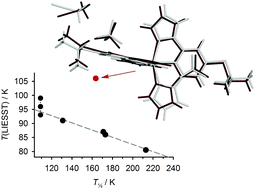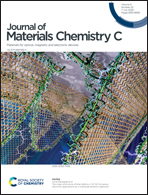Structure:function relationships for thermal and light-induced spin-crossover in isomorphous molecular materials†‡
Abstract
Isomorphous [FeL2][BF4]2·solv and [FeL2][ClO4]2·solv (L = 4-{isopropylsulfanyl}-2,6-di{pyrazol-1-yl}pyridine; solv = MeNO2, MeCN, 0.67Me2CO or H2O) exhibit a variety of thermal spin-crossover (SCO) behaviours. This complexity extends to the light induced excited spin state trapping (LIESST) experiment where, uniquely, five members show the expected inverse relationship between their thermal SCO (T1/2) and LIESST relaxation (T(LIESST)) temperatures but a sixth compound ([FeL2][BF4]2·MeCN) does not. The structural basis of these observations has been probed by X-ray crystallography, photocrystallography and periodic DFT+U+D2 calculations. Among the compounds examined, more cooperative thermal SCO is strongly coupled to order/disorder transitions in the solvent and/or isopropyl substituents and vice versa. A series of symmetry breaking phase transitions in [FeL2][BF4]2·MeNO2, before and after photoexcitation, occurs 10–20 K below T(LIESST) and has no direct bearing on the T1/2/T(LIESST) relationship. These phase changes are not shown by other compounds in the study. The anomalous T(LIESST) in [FeL2][BF4]2·MeCN, and its observed negative lattice expansion during isothermal low → high-spin conversion, are not reproduced computationally which implies those properties are unconnected to its spin state energetics. Its minimised high- and low-spin structures also deviate more from experiment than the other compounds investigated, in the most plastic region of the lattice which includes the solvent molecule. We conclude that reorientation of the linear MeCN molecule contributes a temperature-dependent lattice activation barrier to the spin-transition in [FeL2][BF4]2·MeCN, leading to the higher T(LIESST) value observed.



 Please wait while we load your content...
Please wait while we load your content...